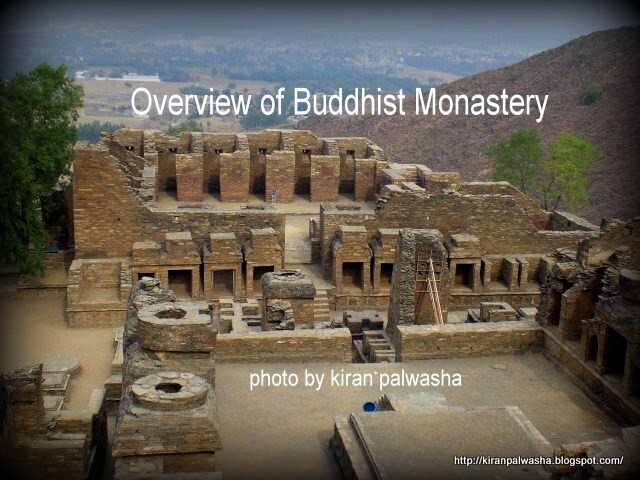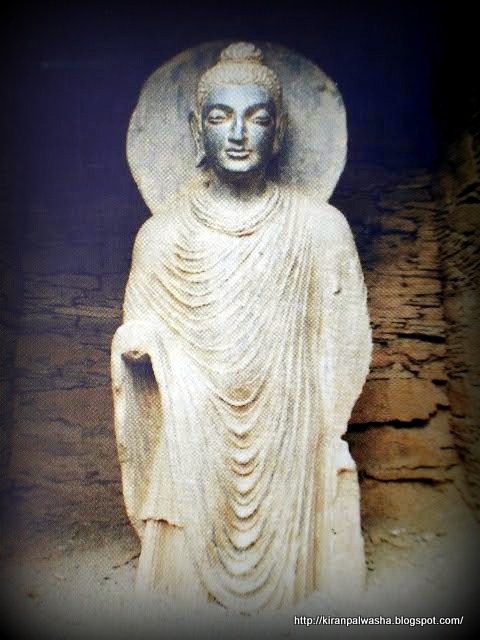Takht e bhai Buddhist remains or ghost town
Buddhist ruins of "Takht e Bhai" are located about 15km north west of Mardan, the second largest city after Peshawar in North West of Pakistan. These remains lies on the top of the hill from the main road leading to swat. This archeological site is one of the famous one among all other Buddhist ruins that have been discovered in Pakistan, and are about 1800ft above the sea level.
UNESCO (United Nation Education Scientific and Cultural Organization) has declared it as world heritage site in 1980.
A joint project by UNESCO and the archeological department of the govt. of Pakistan is carrying out on this site. Under this project, the maintenance and repairing work is going on now days. A freshly new park has been made at the bottom of the hill for the visitors, giving a beautiful look to the site. Labor making flowerbeds and sowing different plants.
The actual location of this monastery is located on the back of the hill. From the main road, one can see only the hill. A full view of the monastery can be obtained from the top of the hill.
Monks used to do meetings in conference hall. Wall of the conference hall are in very fragile condition, support of iron rods have been given to them
from further bending.
This monastery was buried in earth. It was exposed in 1907 to 1908. There was also a residential area for monks in double stories.
Few of sculptures and some other things have been discovered, are now on the display in Peshawar museum.
There are four sided small rooms, where monks used to worship. During 1990's the Buddhist followers were supposed to be meditate here for some hours.
The small holes in each quadrangle are for the ventilation purpose. Small shelves have been made in each quadrangle for keeping candles and other things.
The small holes in each quadrangle are for the ventilation purpose. Small shelves have been made in each quadrangle for keeping candles and other things.
When I visited 5 years back, there was kept a big statue of Buddha in the stupa court, which have been now displaced to Peshawar museum on security basis.
There was possibility of Militants to destroy that statue. During Malakand operation, when lots of Idp’s (Internally Displaced People) were camped in the ground of near by poly technical college, there was possibility of having migrated some of militants to the area. So for security reason that Buddha statue and some of other small sculptures have been shifted to Peshawar museum.
Five stairs leads to the first floor from stupa court to monastery. This monastery was actually double storey building. I have given some of small videos of this monastery and tried to cover each site for better comprehension.
These Meditation cells on the east are very dark. These cells were actually the places of extreme meditation. They are isolated from the rest of monastery, where monks could meditate with full concentration. There is also a courtyard, made for the monks, where they could sit, talk and get some of sunshine.
In spring season this area looks very beautiful and pleasant because of the greenery all around on the hills. But in summers and in
autumn it gives a bit dull look because of much hot and less greenery. Whatever the season, it has its own uniqueness and a
mysterious charm .It looks beautiful and stands with a grandeur in every
season.
In winters especially
it gives a very soothing feelings. One can enjoy the softness of the
warm sun rays on the hilltop. Usually there is silence except the
chirping of birds and the voices of the children, coming far away
from the residential areas of the takht bhai village.
Now
days a group of labors is working on the site for the maintenance so
they are keeping their transistors. They do listen music while doing
their work. It makes this ghost town very lively.
Labors belong from the near village so their children constantly visit their fathers and uncles and bring lunch for them.
Labors belong from the near village so their children constantly visit their fathers and uncles and bring lunch for them.
There was a time when Buddha followers used to visit here from
all over the world. Annually
lot of tourists used to visit these ruins. But now because of security concerns in Pakistan is
declared as unsafe place for the tourists and the increasing control of
militants in swat and the adjacent areas have given a big shock to such
archeological sites. They were no more safe places for visit. But now
things have been changed to some extent and it is hoped to have some
more betterment.
Now day’s only local people do visit here for the sake of entertainment and outing. While local students and other researchers do regular visits to these ruins for their research studies and make reports.Those who visit Takht e Bhai never forget to eat the spicy tasty "Chapli Kabab" that have become a traditional food of here. To see the tasty kabab recipe and pictures click the link below of same blog:
http://kiranpalwasha.blogspot.com/2009/11/famous-chapli-kabab-of-north-west-in.html
Now day’s only local people do visit here for the sake of entertainment and outing. While local students and other researchers do regular visits to these ruins for their research studies and make reports.Those who visit Takht e Bhai never forget to eat the spicy tasty "Chapli Kabab" that have become a traditional food of here. To see the tasty kabab recipe and pictures click the link below of same blog:
http://kiranpalwasha.blogspot.com/2009/11/famous-chapli-kabab-of-north-west-in.html




























These are wonderful photos with very informative captions. This is so sad that we have the greatest treasures of Buddhist cultural heritage but we (both community and government) are doing nothing to protect and preserve these for posterity. Now as the flames of religious fanaticism are on the rise i wonder what is our plan to keep these rare sites protected from militants' onslaught. Excellent work Kiran!
ReplyDeleteHi kiran, thanks for sharing such an informative report. I really appreciate it. Its really giving detail info. about the buddhist monastery. The pictures are very clear. Nice photografhy han...ansa
ReplyDeleteDear Palwasha!
ReplyDeleteExcellent Job; it amazed me. Wish you every success.
Sher Zaman
salaam baji! I checked ur informative mail abt TAKHTBAI. It was wonderfull. I've also been there bt at that time i was quite young' so nothing really to share.
ReplyDeletewasalaam
usaf
Good to see that our government has initiated work on conservation and maintenance of these precious and rare archaeological remains.
ReplyDeleteI still remember when Supreme Taliban leader Mullah Mohammad Omer issued an edict against un-Islamic graven images of animals and humans after which Taliban started destroying all ancient sculptures. In 2001 Taliban destroyed two Buddhist statues in Afghanistan.
Following the decree Pakistani Taliban also destroyed an important Buddhist sculpture in Swat which was about 1,300 years old.
You are right that due to security reasons some of the statues have been taken to Peshawar.
What to say about your photography….excellent work as usual..
I have seen all of your videos, they are wonderful, you look professional docu maker of takht bhai. there was lot of work going on. I think china or japan is helping this work? pa photographara ka de zama na number yoro kha....
ReplyDeleteI also like the new look of your blog, its very nice wallah.
ReplyDeleteHi,
ReplyDeleteNice page and good work,interesting post..thank for sharing.
Amazing. You are so lucky to have such interesting and ancient history nearby.
ReplyDeletewonderful exhibition, Kiran. An homage to Buddha-followers in all worlds.
ReplyDeletei am from takht bhai ,, it is located in KPK province of Pakistan , 86KM far away from peshawar ,and 15 km away from Mardan,,which is district of takht bhai,,, Takht means " A PLACE ON TOP " and Bhai Means "SPRING" ...
ReplyDeleteTakht Bhai is 1800 Feet Above the Sea Surface ,,
Takht Bhai is a heretage Site . The monastry of Takht-i-Bahi was first mentioned by General Court, the French officer of Maharaja Ranjit Singh in 1836.
Takht-i-Bahi is the most impressive and complete Buddhist monastery in Pakistan. This site, dating back to 3000 BC ,,
it means that they are 5000 old ,,, coins of those periods are still found at the site.Takht Bhai (or Takht Bahi) is a Parthian archaeological site in Mardan, Khyber-Pakhtunkhwa, Pakistan. It was first a Zoroastrian complex which, after the later arrival of Buddhism, was then converted into a Buddhist monastic complex,,,there king name was Kanishka,,,
and his father name was kushaan,,, Archaeologists have divided the history of the complex at Takht Bhai into four periods, beginning in the 1st Century BCE. This first era continued until the 2nd Century CE, and is associated with the Kushan king Kanishka, as well as early Parthian and later Kushana king. The second construction period, which included the creation of the Stupa Court and assembly hall, took place during the 3rd and 4th Centuries CE. A third construction period, associated with the later Kushan dynasty and the Kidara Kushana rulers, occurred during the 4th and 5th centuries. The final construction period, which saw the creation of the so-called Tantric complex, took place in the 6th and 7th Centuries CE, and was overseen by invading Hun rulers.Explorations and excavations on this site began in 1864. The site underwent a major restoration in the 1920s,, may u visit to the site, and enjoy alot ,,,
(thanx )